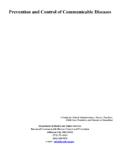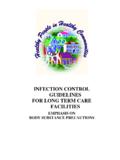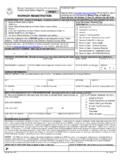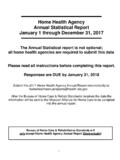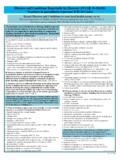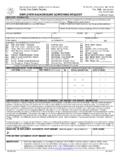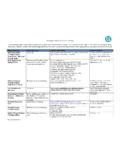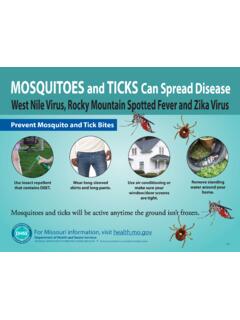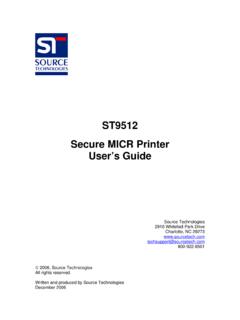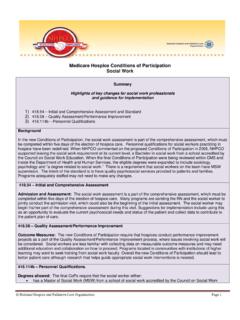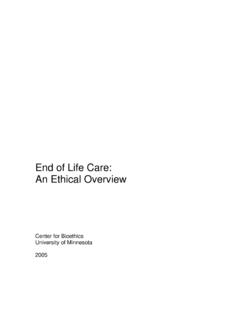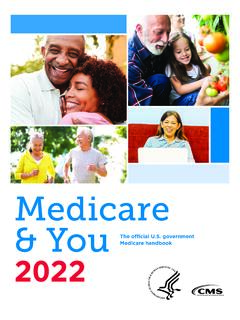Transcription of Guidelines for End-of-Life Care in Long-Term ... - Missouri
1 Guidelines for End-of-Life Care in Long-Term Care Facilities With Emphasis on Developing Palliative Care Goals Guidelines for End-of-Life Care in Long-Term Care Facilities With Emphasis on Developing Palliative Care Goals Guidelines for End-of-Life Care In Long-Term Care Facilities Emphasis on Developing Palliative Care Goals Developed by Missouri End of Life Coalition s End of Life in the Nursing Home Task Force Missouri Department of Health and Senior Services Division of Senior Services and Regulation September 2003 Missouri Department of Health and Senior Services Division of Senior Services and Regulation Missouri End of Life Coalition s End of Life in the Nursing Home Task Force Post Office Box 570, Jefferson City, MO 65102-0570 About Us The Missouri Department of Health and Senior Services enhances quality of life for all Missourians by protecting and promoting the community s health and well being of citizens of all ages.
2 Richard Dunn, Director Missouri Department of Health and Senior Services David Durbin, , Director Division of Senior Services and Regulation AN EQUAL OPPORTUNITY/AFFIRMATIVE ACTION EMPLOYER Services provided on a nondiscriminatory basis The Missouri End of Life Coalition Mission Statement The Missouri End-of-Life Coalition is committed to fostering cooperation, education, and research to promote high quality care for the dying. Chairman - Steven Zweig, MD, MSPH, Professor, School of Medicine, University of Missouri -Columbia Vice Chairman/Chairman Elect - Jim Duff, Diagnostic Clinic, Springfield Secretary - Debbie Oliver, PhD, Associate Professor, University of Missouri -Columbia School of Social Work Treasurer - Jane Armer, PhD, RN, Director, Nursing Research, Ellis Fischel Cancer Center and Associate Professor, University of Missouri -Columbia Sinclair School of Nursing Executive Secretary - Cindy Baird, Missouri hospice and Palliative Care Association Past Chair - Clay Anderson, MD, Assistant Professor, University of Missouri School of Medicine Disclaimer The Guidelines in this manual are not a guarantee of compliance with the regulations for Medicare/Medicaid certified facilities and Missouri licensure.
3 Before implementing these Guidelines , each facility must develop written policies and procedures, specific to each facility, and instruct their staff regarding the appropriate use of these tools. We also recommend that the facility s legal counsel review its policies and procedures prior to implementing them. Acknowledgments The Missouri Coalition s End of Life Task Force gratefully acknowledges the Nursing Facility Quality of Care Fund and Incarnate Word Foundation whose generous gift enables us to provide a copy of this manual to each intermediate care and skilled nursing facility in Missouri . Emphasis on Developing Palliative Care Goals Recognizing a continuing need to discuss critical issues related to developing and revising plans of care for patients residing in nursing facilities at the end of life, the Missouri End of Life Coalition established an End of Life in the Nursing Home Task Force to provide guidance on appropriate palliative care objectives for residents in Long-Term care facilities.
4 The task force and the Missouri Department of Health and Senior Services, Division of Senior Services and Regulation have produced this consensus document. Between 2001 and 2003, the group met with key healthcare agencies and organizations throughout Missouri to ensure that expertise in Long-Term care, pain and symptom management, nutrition, spiritual and psychosocial care, administration, and public health were fully represented. The goals of the task force were to identify barriers to proper End-of-Life care; increase the clarity of the value and role of End-of-Life care goals for LTC facility residents and their families; develop clinical tools to assist in the identification of appropriate residents for End-of-Life care goals and educate care givers about these goals provide for their implementation and appropriate use; identify common language and culture difference and provide education to develop clearer communication; investigate barriers to providing effective hospice services in nursing facilities by profiling existing facilities where hospice care is provided effectively and efficiently; review the conditions of participation related to hospice in facility settings; develop a process by which LTC facilities are encouraged to utilize hospice to provide the benefit from hospice care for dying patients and their families.
5 Provide education for hospices, long- term care facilities, hospice regulators, and long- term care regulators on nursing facilities requirements regarding hospice and End-of-Life care for LTC facilities residents. The resulting Guidelines are a source of information for facility staff. End of Life in the Nursing Home Task Force Marlene Anderson Director of Operations Missouri Health Care Association Cindy Baird Executive Director Missouri hospice & Palliative Care Association Denise Clemonds Executive Director Missouri Association of Homes for the Aging Charles Crecelius, MD, FACP, CMD Missouri Association of Long Term Care Physicians Ginger Farley, ACSW, LMSW, LCSW hospice Preferred Choice Janet Gard Program Director Community hospice of America Tri Lakes Linda Grotewiel, RN Bureau Administrator Missouri Department of Health & Senior Services, Division of Senior Services and Regulation Betty Markway, RN, MSN Missouri Department of Health and Senior Services, Division of Senior Services and Regulation Mary Mitchell, BS, RN Vice President, Resident Services Health Facilities Management Debbie Oliver, MSW, PhD School of Social Work, University of Missouri -Columbia Deborah Reynolds.
6 LPA Admissions Coordinator Boone Retirement Center Don Reynolds, JD Midwest Bioethics Center Yvonne Schwandt, RN Pathways Community hospice Carol J. Scott State Long-Term Care Ombudsman Missouri Department of Health and Senior Services Pamela C. Shipman, RN, BSN Vice President of Operations for Delmar Gardens Enterprises Stephen Smith, MDiv Liberty Hospital Review Committee Department of Health and Senior Services, Division of Senior Services and Regulation: Lisa Byergo, BS Janice Frank, RN Linda Grotewiel, RN Nina Hazelton, JD Betty Markway, RN, MSN Patricia Prince, RNC Bonnie Quick, RN Garry Thompson, MSW Shelly Williamson, BS, MS A special thank you to Rachel Reeder, Editor, Midwest Bioethics Center, for her contributions to this publication. END OF LIFE CARE FOR PATIENTS RESIDING IN NURSING FACILITIES Page 1 of 4 Section: Table of Contents Issued 09/01/2003 Guidelines FOR END OF LIFE CARE IN Long-Term CARE FACILITIES Emphasis on Developing Palliative Care Goals CONTENTS Introduction Purpose Dying in Nursing Homes Defining Palliative Care Principles of Palliative Care Identifying Patients for Palliative Care References Goals of Care Purpose and Objectives Individualized Care Purposeful Observation and Conversations Advance Care Planning A.
7 Defining Quality of Life B. Residents without Decision-Making Ability C. Shaping Care and Setting Goals D. Ethics Case Consultation E. Regulatory Compliance for Advance Directives Describing the Goals of Care A. Ongoing Assessment and Care Plan Revision within the Palliative Care Goal B. Recognizing the Need to Revise Goals C. The MDS and Goal-Setting D. CMS Clarification of Significant Change Assessment Regulatory Compliance A. State Regulation B. Federal Regulation Achieving the Highest Practical Level of Well-Being C. Factors That May Lead to Abuse and Neglect D. Avoidable versus Unavoidable Outcomes Documentation Case Study References END OF LIFE CARE FOR PATIENTS RESIDING IN NURSING FACILITIES Page 2 of 4 Section: Table of Contents Issued 09/01/2003 Pain Management Purpose and Objectives Introduction Responsibility for Effective Pain Relief Common Misconceptions about Pain Consequences of Untreated Pain What Happens If Pain Isn t Properly Treated?
8 Descriptions of Pain A. By Duration, Table 1. B. By Type, Table 2. Pain Assessment Assessing Pain in Residents with Dementia or Communication Difficulty Treatment of Pain A. Rules of Thumb B. The World Health Organization Analgesic Ladder C. Pain Management in the Elderly D. Opioid Use in the Elderly E. Pain Management Risk in LTC Residents F. What Everyone Can Do to Manage Pain MDS and Regulatory Requirements A. State Licensure Requirement B. Federal Certification Requirement References Nutrition and Hydration Purpose and Objectives Nutrition and Hydration in Accordance with the comprehensive Assessment and Plan of Care A. Appropriate Nutrition and Hydration Goals B. Inappropriate Nutrition and Hydration Goals Comfort versus Distress A. Food and Hydration as Comfort B. Food and Hydration as Distress C. Lack of Food and Hydration as Comfort D. Lack of Food and Hydration as Distress Nutrition and Hydration Regulatory End-of-Life Guidelines Medications Parenteral and Enteral Feedings Regulatory Compliance in the Use of Feeding Tubes Family Attitudes Facility staff Becomes like Family References END OF LIFE CARE FOR PATIENTS RESIDING IN NURSING FACILITIES Page 3 of 4 Section: Table of Contents Issued 09/01/2003 Spiritual and Psychosocial Issues Purpose and Objectives Spiritual Care Religion and Spirituality Psychosocial Care Assessing Psychosocial and Spiritual Suffering Psychosocial and Spiritual Care Interventions Regulatory Requirements A.
9 MDS Sections B. The Right to Participate in Groups, State Licensure Requirement C. The Right to Participate in Groups, Federal Requirement D. Social Service, Federal Requirement References hospice Collaboration Purpose and Objectives Definition of hospice Care hospice Services Determination of hospice Eligibility General Criteria Core Services Responsibilities of Providers Responsibilities Related to the Eligibility/Admission Process of LTC Residents Electing hospice Services Integrated Plan of Care Physicians Orders Medical Records Management Utilization of Therapy Services Loss and Grief Services Responsibilities at Time of Death Hospitalization and Emergency Care Revocation/Decertification/Transfer Respite and Acute Patient Care in the Nursing Home hospice Reimbursement Long-Term Care Regulatory Requirements and Expectations for hospice Services A.
10 Regulatory Requirements and Expectations B. Major Concern Areas 1. CMS Identification of Problem Areas 2. SLCR Identification of Major Concern Areas Case Study Sample Integrated Plan of Care after hospice Admission References END OF LIFE CARE FOR PATIENTS RESIDING IN NURSING FACILITIES Page 4 of 4 Section: Table of Contents Issued 09/01/2003 Appendices A. Manual Acronyms B. Glossary C. Care Plans Interventions 1. Gastrointestinal Symptom Management/Care Plan Interventions for the Nurse Aide and Interdisciplinary Team 2. General Symptom Management/Care Planning Interventions for Nurse Aide and Interdisciplinary Team 3. Imminent Death/Care Plan Interventions 4. Imminent Death/Care Plan Interventions for the Nurse Aide 5. Pain Management/Care Plan Interventions for the Nurse Aide D. Pain Assessment Tools 1. Questions about Pain to be included in Routine Nursing Admission Assessment 2. Initial Pain Assessment Tool 3. Pain Assessment Form 4. Pain Assessment Pain Rating Scales E.
